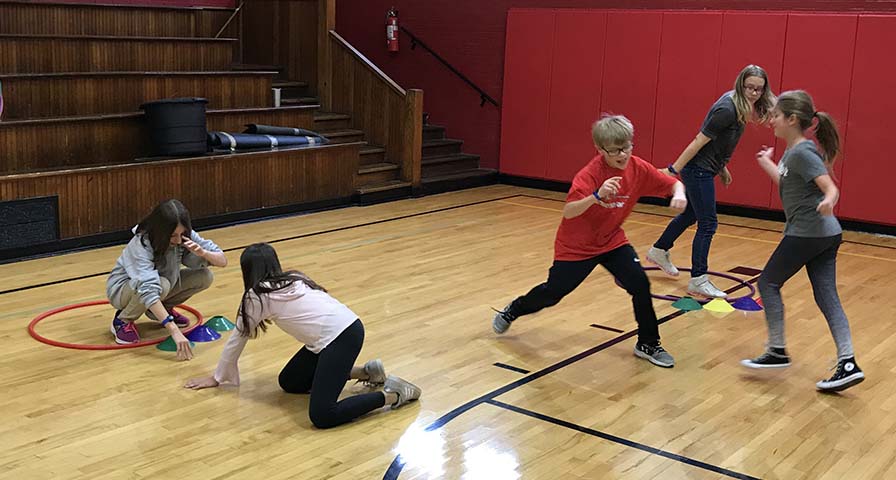Adding Technology Motivates Students of All Abilities to Increase Activity, Keep Heart Rate Elevated During Physical Activity
In just a few short weeks, fifth-grade students at Lincoln (Ill.) Elementary School have begun teaching each other how to improve their fitness using PE heart rate monitors.
Less than a month after Will Navis introduced the IHT Spirit System and IHT ZONE wrist heart rate monitors to his students, they’ve begun to take ownership of their fitness.
In each class session, students work to meet a goal of time spent exercising at an elevated heart rate. When class ends, they line up to return their monitors. As each student returns their ZONE, a summary graph appears on Navis’ computer.
The graph shows each student how much time they spent in each heart rate zone and whether or not they achieved the goal for the day. For the last few classes, students noticed one classmate in particular who always met his goal.
Students Taking Ownership of Heart Rate Training
What’s even more impressive, Navis said, is that the student is not the fittest in the class. But he works hard and stays in his target zones longer than classmates. Other students have noticed.
“Students are going to him and asking what he’s doing, and I think that’s really cool because that’s not often the case,” Navis, who is also the current president of the Illinois Association of Health, Physical Education, Recreation and Dance, said.
His advice to classmates: never stop moving.
“It’s been really great to see and he’s taking ownership in it, talking about what he does,” Navis said. “He doesn’t stop moving. We were doing a throwing invasion game last week. When you caught the ball, you couldn’t move. Instead of standing still, he jumps up and down. He’s telling his classmates. Then on Friday, I noticed more of his classmates doing that, and we saw more of the class hit the target than before.”
The student interaction and understanding of what it takes to reach individual goals – and improve overall fitness in the process – more than justifies the teacher’s decision to add the PE heart rate monitors to his program.
Understanding PE Heart Rate Data: ‘It’s All Individual’
The individual heart rate focus drew Navis to IHT’s technology as opposed to other systems that project student data onto a screen or wall. His students, he said, need to focus on their heart rate. They don’t need to see how it compares to other class members. Seeing the numbers projected on a screen becomes more of a distraction than a motivator.
“I work with elementary students, and if there’s something up on a screen or a wall, that’s where their eyes would be as opposed to being focused on moving safely,” Navis said.
The individual heart rate focus drew Navis to IHT’s technology as opposed to other systems that project student data onto a screen or wall.

When he introduced the PE heart rate monitors, Navis saw several students comparing heart rates while waiting to return the ZONE monitors. Students can also see the graph of their heart rate during activity on his computer. Navis uses their curiosity to help reinforce the individual aspect of each heart rate reading and graph.
“Whatever level you’re at fitness-wise, it’s all individual,” he said. “At the end [of class], as they are [returning] they can see on the left of the screen who got the number of minutes [needed for that day’s goal].”
Students have focused more on making the daily goal for time spent exercising in the target zone and changing their routine if they don’t make the goal one day. The colors on the heart rate graph make a workout summary easy to understand.
“Having the monitors, and when they return them and see that quick pop-up of the graph, they can see, ‘oh, I was in blue [heart rate zone] a lot today’ and then the next class they come in and try to avoid that,” Navis said.
Teaching Young Students the Value of Heart Rate Training
Navis wants students to focus on their heart rate, and the zone they are exercising in. For his younger students, Navis teaches students what each color on the ZONE heart rate monitor represents:
- blue heart rate zone for low-intensity activity
- yellow heart rate zone for moderate-intensity activity
- red heart rate for vigorous-intensity activity
“They don’t really understand what [their actual heart rate number] means yet, especially in third grade because we don’t introduce it in our curriculum until fourth grade,” Navis said. “I want to shift them more toward the colors. They’ve responded very well to that, which is nice.”
The response has been constant motion during class. Adding the heart rate monitors has given students more motivation to heed his movement mandate.
“I don’t like students standing still,” he said. “Now, I’m seeing a change in what they are choosing to do so they keep their heart rate up higher. They look for ways to build and maintain the moderate to vigorous activity level.”


